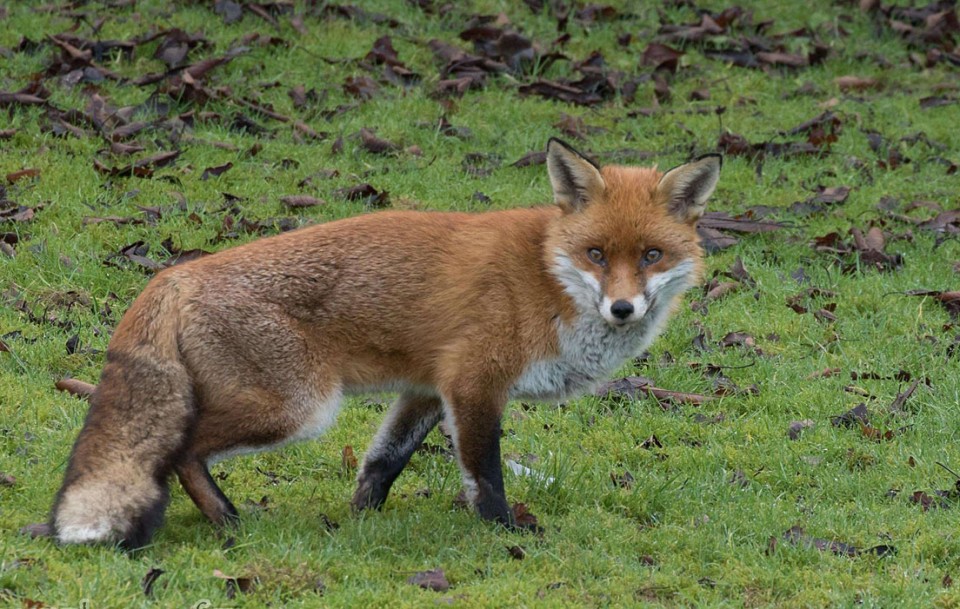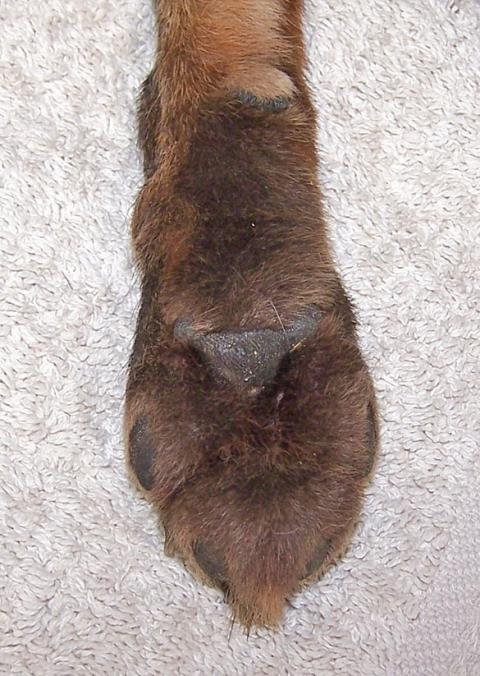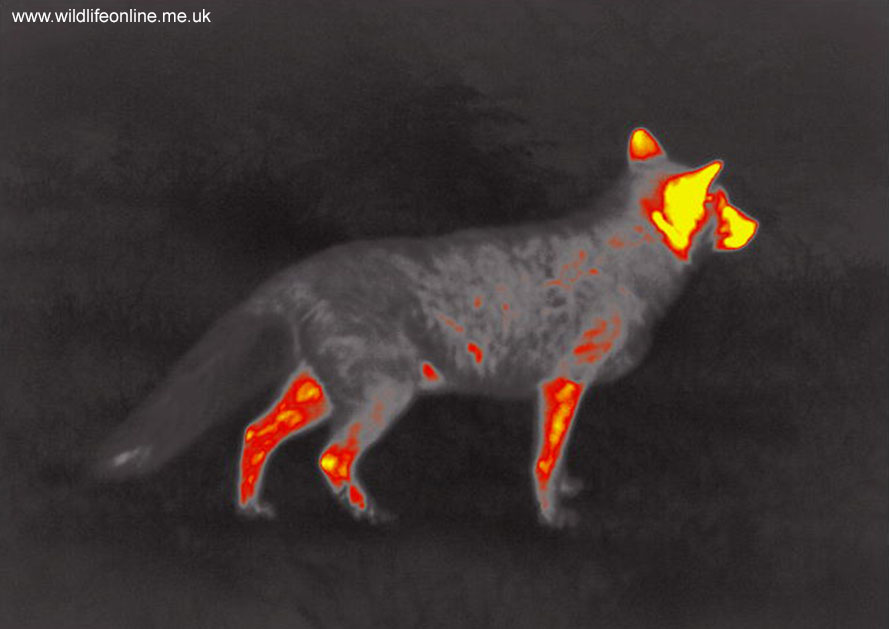Red Fox Appearance
Red foxes are medium-sized canids with a skull similar to that of a domestic dog, but narrower with a slender, whiskered muzzle and large pointed, erect ears. The fox has an elongated body with slender limbs and a long bushy tail (accounting for about 40% total length) up to about 13cm (5 in.) in diameter. The nose is typically black, although individuals do occasionally present with depigmentation, resulting in a pink or blotched nose (“dudley nose”).

They have very light skeletons with long hind legs for their size. Indeed, in his comparative study of canid morphology, published in 1954, the scholarly American zoologist Milton Hildebrand calculated that Red foxes had disproportionally longer hind legs compared with other closely related members of the dog family. Hildebrand didn't speculate on the significance of this trait, but some two decades later, J. David Henry suggested that it allows foxes extra propulsion when pouncing from their deep crouch. Overall, Hildebrand identified seven bones (the sacrum, sternum, scapulae, lumber vertebrae, baculum, ulna and fibula) that, in foxes, are significantly reduced in their relative width versus other canids; probably helping to keep them lightweight.
The forepaws have five digits, four are in contact with the ground and the fifth, a dew claw on the back of the leg sits about 15mm (0.6 in.) off the ground. Once thought to be vestigial, a recent paper by Russian zoologist Jan Englund proposes that it may serve to help catch small mammals, by increasing the reach of the claws in the event that prey has moved during a pounce. The dew claw is lacking on the hind feet, which would seem to support this hypothesis. All paws are furred on the pads (left), which helps muffle their approach, prevent heat loss and provides sensory information while hunting. The pad arrangement is roughly oval, compared to the more rounded arrangement observed in many other canids, including the domestic dog. The body proportions and gait are such that walking foxes leave a '12-5-3 rule' track—tracks have a stride less than 12 in. (30 cm), a straddle of fewer than 5 in. (13 cm) and a track length of less than 3 in. (8 cm).

The eyes are situated at the front of the skull, providing binocular vision and each possesses a nictitating (protective) membrane that moves only when the eye is closed. Vertically-slit oval pupils are surrounded by a large iris, which is slate-blue in cubs, owing to a lack of the yellow pigment lipochrome (see Breeding Biology), changing to gold/amber at around 4-5 weeks old. A layer of reflective cells called the tapetum lucidium (meaning roughly “bright carpet” in Latin) sits behind the retina and reflects light back into the eye, improving vision under low-light conditions (see Senses) and causing eye shine. Eye shine is a form of iridescence, which means that the colour of the reflected light can vary according to the angle you're viewing it from. Nonetheless, eye shine is generally either white or blue/green when viewed head-on, or pinkish-orange when the animal isn't looking directly at the light source.
The fox fur coat
Foxes are highly prized for the colour and texture of their fur and animals are still farmed (notably in the USA, Canada, and Scandinavia) for their pelts. In a 1986 paper to the Canadian Journal of Zoology, Daniel Maurel and colleagues, at the Centre National de la Recherche Scientifique in France, described how the Red fox coat consists of three fur types: fine underfur (awn hairs) that traps air close to the skin, thereby providing insulation; the longer coarser guard hairs that provide water resistance and give the coat its prized sheen/lustre; and intermediate hairs, which are similar to guard hairs, but smaller (shorter and thinner). The hairs are arranged in bundles called “triads”; one guard hair and two intermediate hairs, associated with varying numbers of awn/underfur hairs.

The underfur covers the sides and back of the animal and is short (about 35mm, just less than 1.5 in.) and grey in colour. The guard hairs are longer, varying in length across the coat (longest on the tail), and protrude through the underfur - guard hairs are so called because they 'guard' the underfur awn hairs from damage. Coat length varies according to geography and season; in Europe and North America, northern animals have longer coats than southern animals and winter coats are generally longer than summer ones. In some cases, guard hairs fail to grow and the underfur is curled, giving the animal a “woolly” appearance - these are referred to as Samson foxes.
Foxes do not sweat in the conventional sense—they have sweat glands (called apocrine glands) associated with their hair follicles, but they do not excrete water in a bid to cool the body (it has been suggested the glands instead play a scenting role). Consequently, the shortest fur covers the face (muzzle, around eyes and on top of head), ears, lower legs and paws (altogether about 30% of the animal's surface area); most heat is lost in these areas, helping the animal to cool down. When viewed through a thermal imaging device (i.e., a special camera that registers heat output rather than light) it can be seen that foxes also lose heat from their shoulders and along their back and shoulders. Little heat is lost from the neck and flanks and virtually none from the brush.
White-tipped brushes
A very common feature among all colour morphs of foxes is a white tip (or “tag”) to the tail that is noticeable on a cub's tail, even before it is born (by around 46 days into gestation) and, in adult British foxes, covers up to about 10cm (4 in.) of the brush. The tail tip is often larger in North American foxes and, both there and in Europe, northern animals tend to have longer white tips than southern animals. In An Irish Beast Book, James Fairley commented that:
“The brush [tail] always has a white tip, or at least it had on the thousand or so foxes I looked at. But sometimes this 'tag' is minute.”
In a brief paper to the Proceedings of the Zoological Society of London during 1963, however, Gordon Corbet discussed the frequency of white tail tips among British mammals and arrived at a different conclusion. Corbet looked at skins kept at the British Museum and found that 11 (73%) of the 15 skins from England and Wales, and 27 (87%) of the 31 collected from Scotland had a white tip to the tail, giving a total occurrence of 83%. In his paper, Corbet noted that the hairs were albino (i.e., devoid of any pigment) and that, among foxes: “a white tip is normal but by no means universal”. Additionally, I have seen reports of black and grey tips, and, in October 2020, a lady in East Sussex contacted me to report a couple of encounters she'd had with a fox that had a black tip to its tag:
“The white was not large, just a good tip, and the black was just the tip of the white - very black - maybe one eighth, tenth - seemed to go to a point ...”

Some authors have suggested a white tip may assist with communication. In Sussex I observed one fox following another through quite dense vegetation in poor light; the one behind appearing to pay close attention to the brush tip of the one in front, which was conspicuous even to my poorly-adapted eyes. Many early authors and countrymen have also maintained that it was possible to sex a fox based on the tail tip; the white tip was indicative of a male. This is not the case and either sex can possess a white tag.
Finally, in her 2000 book, A New Forest Fox Family, Thelma Clarke mentioned an interesting, apparently inherited, “pompom” condition in two of the foxes visiting her cottage. Clarke described a handsome dog fox that she named Bobble Tail; he had a brush ending in a snow white tip but that looked like it had an elastic band around its base, making it fluff out into a perfect pompom, “... good enough for any bobble hat”. Bobble Tail had a sister, a vixen that Clarke described as a smaller replica of himself, who sported this flashy pompom too, but on a smaller scale. Unfortunately, this is the only reference Clarke makes and none of her photos show the condition.
Coat insulation
The winter coat of the Red fox is highly insulative and is a significant part of this species' ability to push its distribution into the Arctic Circle, albeit in sufficient for them to survive in the High Arctic. Data for Alaskan Red foxes in winter pelage, published in Physiological Zoology in 1955 by Laurence Irving and colleagues at the Arctic Health Research Center, demonstrated that their metabolism started to rise when external temperatures dropped below -13C (8.6F) and had almost doubled by -50C. Experiments on captive Arctic foxes, published by Per Fredrik Scholander and colleagues in a series of papers to Biological Bulletin in 1950, by contrast, showed their metabolic rate only began to rise when temperatures fell to between -45C and -50C (-49 and -58F) and they only began to shiver after more than an hour at -70C (-94F). These data explain why Arctic foxes can colonise the Arctic tundra, while Red foxes currently cannot.

More generally, the insulative properties of the fox's winter coat can sometimes be seen with the naked eye. During cold weather, it is not uncommon to see frost or snow on the coat that can remain for considerable periods, indicating very little body heat is lost through the coat. Similarly, viewing a winter-coated fox through a thermal imaging camera shows very little heat loss, with the tail being particularly well insulated. Indeed, thermal images of foxes in their winter coat typically show the tail the same colour as the surroundings, indicating virtually no heat is lost over the brush.